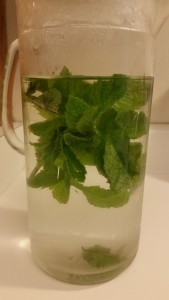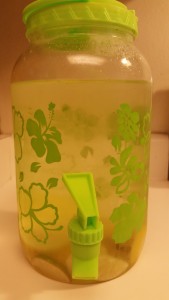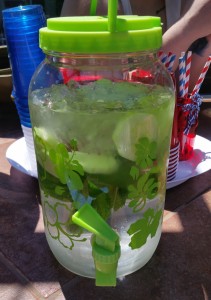Water
My sister and I had a texting conversation about chronic dehydration. Considering humans are supposed to drink half our body weight (lbs.) in ounces of water per day, most people are dehydrated, including myself. For example, a 200-lb person should drink 100-oz of water per day; that is 12.5-8oz glasses of water per day. This means the commonly quoted 8-8oz glasses of water is acceptable for a 128- lb. person (8 glasses x 8 oz./glass x 2 lbs./oz. recommended = 128-lb person). One hundred and twenty-eight pounds is my goal weight, not my current weight, and I don’t drink 8 glasses of water a day.
We often mistake feelings of thirst with hunger. To avoid consuming extra calories from snacking and attempting to eat away thirst, first drink an 8-oz glass of water and wait 20 minutes. If you are still hungry, then have a healthy snack.
To calculate the amount of water in ounces you should drink daily, multiply your body weight by 1/2 if you are not active and 2/3 if you are active.
Recommend watering schedule: Divide your water amount by eight; this is the number of ounces in your glass (not the standard measure of 8oz).·
- 1 glass upon waking first thing before coffee (around 7:00 a.m.) This helps hydrate your body and replenish your organs after a good night’s sleep. Ideally, this glass is thirty minutes to one hour prior to breakfast so you don’t dilute your digestive juices.
- 1 glass an hour after eating breakfast (around 9:00 a.m.) to help nutrients from breakfast absorb into the body. Try not to drink too soon after eating because water will dilute your digestive juices.
- 1 glass half an hour before lunch (around 11:30 a.m.)
- 1 glass an hour after lunch (around 1:30 p.m.) to help nutrients absorb from lunch into the body.
- 1 glass in the afternoon around 3:00 p.m. to prevent snacking.
- 1-2 glasses around 5:00 p.m. Or at least a half an hour before dinner to help from overeating at dinner.
- 1 glass an hour after dinner around 7:00 p.m. to help with absorption.*
- 1 glass an hour before bedtime to help hydrate before sleep.*
*If you have the propensity to wake up at night to use the bathroom, avoid drinking after 6:00 p.m. Also, waking up to pee may be a sign of a more serious problem, and you may need to consult your doctor.
Alternative schedule: if drinking water throughout the day just isn’t your thing, try drinking 1/3 of your daily allotment first thing in the morning, 1/3 an hour before lunch, and the last 1/3 an hour before dinner. Just do your best to get the water into your body.
Water Taste and Flavor
This may sound strange, but there is a taste difference between bottled water brands. Well, I notice a difference anyway. My preference is reverse osmosis water, and my preferred bottled water is Sparkletts or Crystal Geyser. If you are the type of person who does not drink water because it tastes bad, try different brands. Alternatively, you can try flavoring the water with herbs or fruits.
Flavored Water: Fruits and fresh herbs can be used to infuse water with flavor with adding artificial sweeteners or flavorings. You can’t really go wrong with a combination of fruits and herbs, but there are a bunch of ideas from www.infusedwaters.com to start. Some of my favorites are:
- Cucumber: slice 1/2 a cucumber per gallon. Let seep for thirty minutes.
- Cucumber mint: add half a cucumber and one sprig of mint leaves per gallon.
- Mint: one sprig of mint leaves per gallon.
- Lemon: slice one lemon per gallon (remove rind from less bitter taste)
- Lemon strawberry: slice one lemon and 5oz frozen or fresh strawberries per gallon
- Lemon and orange: one lemon and one orange (remove rind from less bitter taste)
- Strawberry lime: slice one lime and 5oz frozen or fresh strawberries per gallon
Over consumption of water: There is a risk of drinking too much water. Being too hydrated can deplete your electrolytes. If you start getting headaches, stop and consult a physician.
Water Weight gain:As you increase your water intake, you may notice an increase in the scale, but do not be alarmed. This increase is just water weight. Water weight is not body mass. The increase water helps improve your organ function and clear metabolic wastes from your body. Additionally, water is a necessary reactant in the breakdown of macromolecules (fats, carbohydrates, proteins, and nucleic acids). In order to lose body mass, your body uses water molecules to break bonds holding fats together. As you increase the amount of water in your body, your body has the ability to increase its metabolism of fat and ultimately reduce the amount of body mass. So don’t worry about a jump in the scale once you start a water regiment. Keep drinking, and your body will thank you.
Naturally Unnatural Foods
I started noticing an increase in the number of products containing the word “natural” across the front of the package. It seems odd that a prepackaged product was claiming to be natural. When I think of natural food, I think of fresh fruits and vegetables, fresh meats, and grains; foods that have a short shelf life due to the lack of preservatives. Why and how could a premade, prepackaged product that isn’t refrigerated be natural?
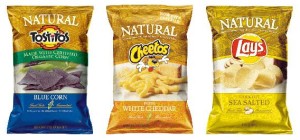
By definition, natural means “existing in or caused by nature, not made or caused by humankind.” So natural foods are foods that occur naturally on earth without modification, right? Unfortunately, Webster’s definition does not carry over to the corporate world because the FDA has yet to legally define a standard for the term natural because most food products have been manipulated or modified in some way. As such the recent consumer trend toward natural lifestyles, green living, and reducing carbon footprints has led to a distortion of the word, and the term natural has been hijacked by manufactures to promote unhealthy products. Food manufacturers are slapping “natural” 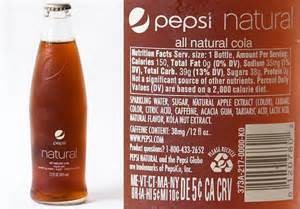 onto packages hoping consumers assume that the product has minimal processing or no additives, but those assumptions are ill founded. Bags of Natural Blue Corn Tostitos, Natural Cheetos, and Natural Lays potato chips grace the chips isle, which can be paired with Natural Pepsi. Really, I will have to keep my eyes peeled for a chip producing tree or a Pepsi spring on my next hike.
onto packages hoping consumers assume that the product has minimal processing or no additives, but those assumptions are ill founded. Bags of Natural Blue Corn Tostitos, Natural Cheetos, and Natural Lays potato chips grace the chips isle, which can be paired with Natural Pepsi. Really, I will have to keep my eyes peeled for a chip producing tree or a Pepsi spring on my next hike.
Also, I just read an article in UCLA Health regarding liver damage (hepatotoxicity) due to over-consumption of nutritional supplements and non-steroidal pain relievers. “The most common supplement-induced liver injuries result from workout or bodybuilding supplements, with weight-loss supplements not far behind. Less common but still important to be aware of are injuries from consuming large quantities of popular energy drinks” and acetaminophen. A distrust or frustration of western medicine and/or desire for a quick, easy fix has consumers looking at herbal or natural supplements. But natural isn’t always good. Suppose I was allergic to strawberries, then I should avoid strawberries even though they are natural. Poison ivy is natural, but who wants to roll around naked in the leaves? Cancer is natural; do you want some of that? Just because something is natural, doesn’t make it good for you. Plus, supplements are not regulated by the FDA, so the claims and ingredients are not tested. Who knows what and how much you are actually ingesting. Here some supplement consumers are literally destroying their livers by something they think is natural. The liver is the body’s filter. Every chemical that enters the bloodstream gets processed by the liver. If you overload the filter with natural or unnatural chemicals, then the liver gets clogged and stressed out, which can lead to cell death and tissue scarring (cirrhosis of the liver). Since the human body only has one liver, once the liver is damaged it must be replaced and there is a long list for liver transplant requests.
On the bright side, liver damage can be stalled by changing to a healthy, truly natural diet. Truly natural foods are those that don’t require a label. Stick with those.
An Apple a Day Made Me Fat
How many times have you heard, “If you eat healthy food, then you can eat as much as you want and not gain weight?” I have heard this many times online, on news, in books, etc., but it is not true. Eating healthy food can make you fat: consuming more calories than calories burned leads to weight gain. Let’s use my numbers as an example. (I apologize to anyone who doesn’t like numbers, but this is important.)
I gained 30 pounds over the course of 10 years. That means over the course of ten years I consumed 105,000 more calories than I burned because one pound is equal to 3500 calories. That means per day (there are 365.25 days in ten years) I consumed 28.7 more calories than I burned. There are 72 calories in a medium size apple 2-1/2″ in diameter. That means, if I had not eaten one medium sized apple a day, I would have lost weight!
Okay so there are other health benefits to apples, like fiber, vitamins, minerals, etc. and this may be an over simplification, but I hope you get my point. Eating too much of a good thing does not lead to a good thing. Portion size matters no matter what you are eating. All calories count.
It is true that the source of the calories matters too. A 72 calorie apple provides more nutrition than a 72 calorie cookie. Both contain sugar, but the apple contains more vitamins and dietary fiber while the cookie contains more fat and sodium. And the apple should leave you feeling more “full” than the cookie due to the dietary fiber.
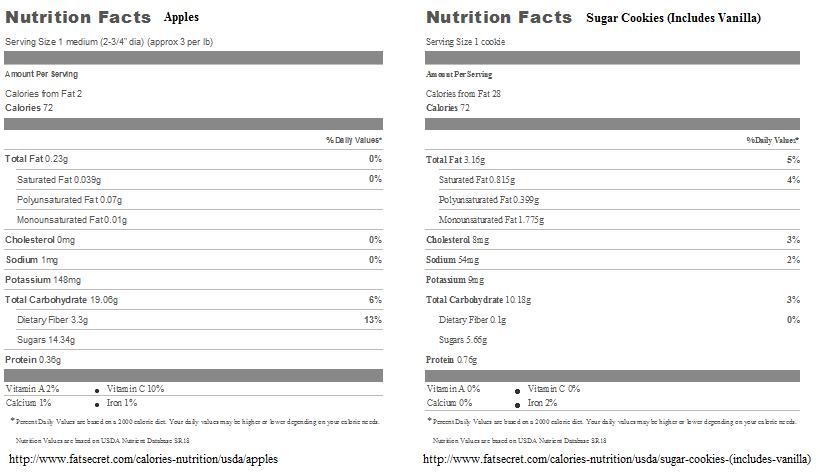
Ultimately, the apple is the better choice. But one cannot live on apples alone. Nor can one avoid cookies forever. Balance and moderation are key. In the diet section of the blog, I will share healthy, tasty recipes that I have enjoyed for years as well as new ones that I either stumble across or you share with me.
Size Matters!
Subconscious Cues of Plate Size and Color in Food Consumption
As I was looking at my food pictures, I started thinking that I should buy new plates to improve the aesthetics. Of course, I am the kind of person that likes to research everything and turn something that should be a simple decision into a complicated, overthought dilemma. As such the process of buying new plates brought out the following research questions:
1- How can I maximize the aesthetics of my pictures and simultaneously use visual cues to eat less food and achieve my weight goals?
2- What size plates should I buy? What size are my current plates vs the plates I used in college?
3- What color plates should I buy? Are there colors to help decrease hunger and increase meal satisfaction?
We eat with our eyes; a large portion of the dining experience is visual, and using visual cues you CAN trick yourself into feeling more full on less food. There is plenty of evidence on the psychology of visual perception and how the arrangements of objects can influence our perception of the objects. In addition the contrast between those objects effects our perceptions as well. Researching sensation and perception contributions to enhance the dining experience led me to Brian Wansink, Ph.D., the author of “Mindless Eating”.
The size of the plate plays a bigger role in food consumption than just how much food the plate can hold. Physically, a smaller plate holds less food than a larger plate, so the diner eats fewer calories when the food is served on a smaller plate because the diner was given a smaller portion. But at home wouldn’t the person just fill a smaller plate twice to eat just as much food or more similar to dining habits at a buffet? Often times the answer is no. Psychologically, a smaller plate allows the diner to feel more full on less food.
Psychology sneaks into our dining experience and plate size influences hunger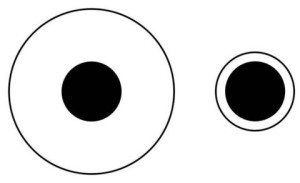 satiation subconsciously. This has to do with the visual illusion called the Delboef illusion first documented by Franz Joseph Delboeuf in the 1860s. When a circle is placed inside another circle, the size of the inner circle is perceptually influenced by the size of the outer circle. As the outer circle increases in diameter, the inner circle appears to get smaller even though the inner circle’s diameter has not changed.
satiation subconsciously. This has to do with the visual illusion called the Delboef illusion first documented by Franz Joseph Delboeuf in the 1860s. When a circle is placed inside another circle, the size of the inner circle is perceptually influenced by the size of the outer circle. As the outer circle increases in diameter, the inner circle appears to get smaller even though the inner circle’s diameter has not changed.
So how does this relate to hunger satiation? In a study by Anderson, Schaumberg, Anderson,and Reilly,[1] subjects were randomly assigned either a 12” or 8” plate and allowed to serve themselves as much pasta with tomato sauce as they would like. Prior to the experiment subjects fasted for four hours and following the experiment, subjects completed an Intuitive Eating scale and rated the food on levels of taste. Intuitive eating focuses on internal hunger and fullness cues rather than external cues. The results of the study show that “higher levels of intuitive eating were associated with greater food consumption… participants ate more pasta in the large plate condition… [and] the influence of plate size on food consumption increased as levels of intuitive eating increased.” In other words, subjects given larger plates ate more pasta and reported a higher level of fullness. Note, even though the subjects who were given the small plates were allowed to eat more (i.e. go back to the buffet line), they didn’t. They stopped eating because they were “full” on less food.
According to Dr. Wanskin’s research, the average person will eat 92% of the food they serve themselves, and the average person fills about 70% of the plate regardless of plate size. In the early 1990s, the standard size for place settings (plates, bowls, cups, etc.) increased. The dinner plate size increased from 10-inches to 12-inches. This increase leads to you eating approximately 22% more food at a meal.[2] So if your meal was 1000 calories on the 10-inch plate, then you are eating 1220 calories on the 12-inch plate, and you subconsciously feel the same fullness. Being generous, suppose you only overate 220 calories per day and not per meal, then 220 calories/day means you would gain one pound every 16 days. And in ten months you would have gained 20 pounds.
Out of curiosity, I decided conduct an at home experiment with the dinner plates I have used for the last ten years and compare those plates to the plates I used in college.
1- measure the diameter of each type of plate
2- measure same amount of food on each plate and compare visual impression.
Results:
1- The current plates vary slightly. 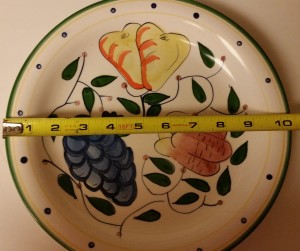
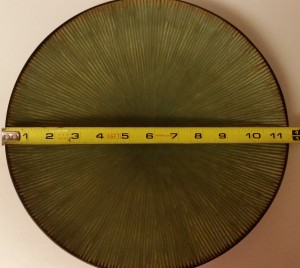
Green = 11.5-inches,
fruit plates 10.5-inches
College plates = Orange plate = 7.5-inches
Holy cow. I remember purchasing the green dinnerware when I moved into my apartment. I was so excited to have a nice grown-up set of 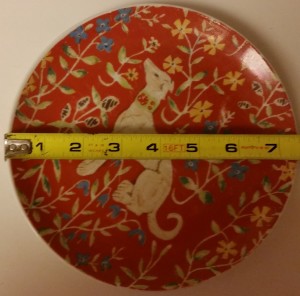 dishes, and I thought they were so pretty. At the time, I remember thinking they were large, but I had no idea of the consequences.
dishes, and I thought they were so pretty. At the time, I remember thinking they were large, but I had no idea of the consequences. 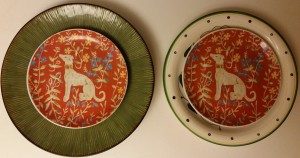
2- Served 1 cup pasta with ½ cup sauce on each dinner plate. The serving on the large green plate looks smaller than the serving on the small orange plate.
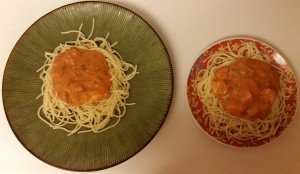
Color Cues
The next question that needs to be answered before making my purchase: what color plate should I buy? Similar to plate size, color plays an important role in tricking your mind while eating. Another study by Wanskin and van Ittersum at Cornell University shows that plates with the most color contrast with the food can trick you into eating less. In the study, subjects were given white or red plates and then told to serve themselves pasta with red sauce or pasta with while Alfredo sauce. Subjects who were given red plates and served pasta with red sauce and ate 22% or 32 grams more than subjects with white plates with red sauce. Conversely, for the Alfredo sauce, subjects with white plates served and ate more. [3] In addition, “reducing the color-contrast between the dinnerware and its background (i.e. table, tablecloth or placemat) helps reduce over-serving by as much as 10%.” Hmm, I guess I need to buy placemats too.
There have been numerous studies to find the “best” plate color to encourage eating less, but many of these studies seem to contradict each other. One study suggests red plates are best because we socially associate the color red with danger and stop. Another study suggests blue plates because the color blue is the least common naturally occurring food color and will contrast with the most foods. Another study suggests white plates for a similar reason. And yet another suggests green plates because we should eat more green vegetables and less white pasta.
Using this knowledge, I decided to purchase two different plates with a 8-9″ diameter: A brightly colored plate for light colored meals like Alfredo, chicken and rice, fish, etc. and a light colored plate for dark colored meals like beef, salmon, salad, etc. Why 8-9” and not 10”? Because I am impatient, and I want to lose weight faster. Plus, I typically have a salad with dinner in a salad bowl. The plate is just for the entrée and side. Lastly, I don’t like measuring. If losing and maintaining a healthy weight means I have to measure and/or weight out portion size for the rest of my life, then it’s not going to happen. Measuring food portions is not a realistic, sustainable practice. Sure I’ll measure portion size now and again, but ultimately I am going to get lazy and stop measuring. At which point, I’ll have to rely on visual cues and memory to correctly serve meals. So I might as well get the smaller plates to keep the food consumption in line when the laziness kicks in.
Update:
The new plates arrived. I purchased them from target.com: one white set and one blue set. These are actually salad plates. I couldn’t find small dinner plates other than paper plates. Most of the dinner plates are 11-12″ in diameter.
Blue: Threshold™ Belmont Stoneware Reactive Salad Plates
White: Threshold™ Bone China Coupe Salad Plates
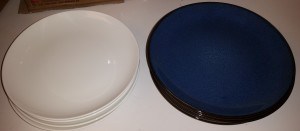
[1] Is Level of Intuitive Eating associated with Plate Size Effects? Anderson DA, Schaumberg K, Anderson LM, Reilly EE, Eat Behav. 2015 May 19; 18:125-130. Doi: 10.1016/ j.eatbeh.2015.05.005
[2] “The Perils of Plate Size: Waist, Waste, and Wallet (2008), Brian Wansink and Koert van Ittersum, Journal of Marketing (under advanced review).
[3] Van Ittersum, Koert, & Wansink, B. (2012). Plate size and color suggestibility: The Delboeuf illusion’s bias on serving and eating behavior. Journal of Consumer Research, 39(2), 215-228

